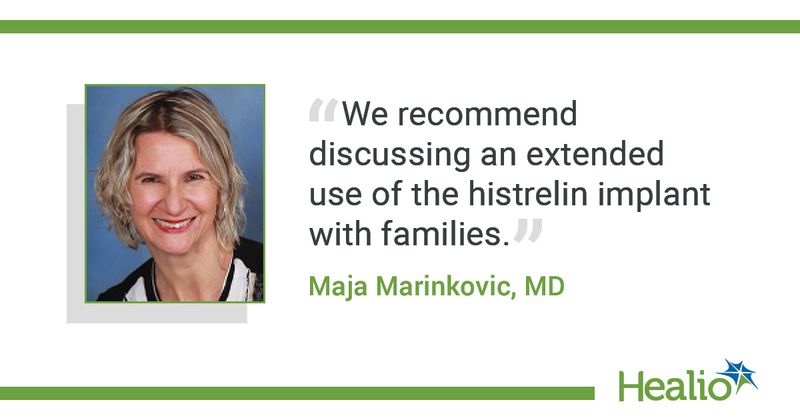Extended histrelin implant use an option for transgender care, central precocious puberty
Key takeaways:
- Most youths who had a histrelin implant in place for 17 months or more had a biochemical response.
- Clinical examinations and laboratory measurements should be used to determine implant placement and removal.
Most transgender youths or children with central precocious puberty had a sustained biochemical response after using a histrelin implant for more than 17 months, according to a study published in Transgender Health.
“Our study has high clinical relevance for the providers who care for transgender/nonbinary youth as well as for children with central precocious puberty,” Maja Marinkovic, MD, associate clinical professor in the department of pediatric endocrinology at the University of California, San Diego, and medical co-director of the Center for Gender Affirming Care at Rady Children’s Hospital-San Diego, told Healio. “The study results indicate that extended use of histrelin implants for more than 17 months in transgender/nonbinary and central precocious puberty youth was efficacious and safe. The average time of clinical, biochemical or combined pubertal escape occurred at approximately 30 months.”

Marinkovic and colleagues conducted a retrospective review of electronic health records at two U.S. pediatric centers. Children and adolescents with gender dysphoria or central precocious puberty who attended either center from 2010 to 2020 and had a histrelin implant in place for 17 months or more were included. The choice to retain the histrelin implant for longer than 1 year was based on the provider’s decision to offer it and the patient and their family’s preference. Follow-up visits occurred every 3 to 6 months, and histrelin removal or replacement was discussed at each visit occurring more than 1 year after placement. Histrelin implant efficacy was determined by unstimulated sex hormone and luteinizing hormone concentrations. Puberty progression and escape were defined biochemically or through clinical examination.
Long-term histrelin implants for transgender youths
There were 49 children and adolescents in the study, of whom 42 were transgender or nonbinary youths and seven were youths with central precocious puberty. There were 27 participants assigned female at birth and 22 assigned male at birth. Pubertal suppression occurred for at least 15 months in all youths; average length of use of a single histrelin implant was 37.5 months. The longest biochemically confirmed efficacy with a histrelin implant was 48 months in a child with central precocious puberty and 43 months for a transgender male.
There were 25 transgender or gender nonbinary participants who were treated with a histrelin implant alone beginning at a mean age of 11.7 years. The mean biochemical efficacy in the group lasted 25.5 months. Implants were removed for nine youths at 40.3 months after placement.
There were 15 transgender or gender nonbinary adolescents who had a histrelin implant along with gender-confirming HT. The group began pubertal suppression at a mean age of 12.8 years. HT began 5 to 18 months after histrelin implant placement. Pubertal suppression that was due to the histrelin implant was difficult to confirm within the group due to the impact of HT. Of the group, transgender females had a mean estradiol of 99.4 pg/mL. All transgender females achieved their desired testosterone suppression and reached Tanner stage 3 to 5 in breast development. Transgender males had a mean serum testosterone concentration of 259 ng/dL, but not all reached the full testosterone replacement dose during the study. Of the group, five had their histrelin implant removed and one had it replaced.
There were two transgender or gender nonbinary adolescents who had a histrelin implant placed at a mean age of 14.7 years and at Tanner stage 5. Incomplete data were available for the participants due to irregular follow-up.
“We suggest that clinicians use both clinical examinations and laboratory studies to determine the optimal time for placement and removal of the histrelin implant as random serum hormone concentrations in our group were not sensitive measurements of pubertal start and pubertal suppression,” Marinkovic said.
Biochemical efficacy reached at about 2 years in central precocious puberty
Among seven children with central precocious puberty, treatment began at a mean age of 7.9 years. One child had two implants placed, with both in place for at least 17 months. Implant efficacy was confirmed at 24.9 months for all participants. All eight implants were removed at a mean 27.5 months.
Pubertal escape occurred in 16% of transgender and gender nonbinary participants. Escape occurred at a mean 30.4 months after insertion of the implant.
There were 23 implants removed during the study. Of 22 cases that had surgical reports available, 86.4% had uneventful procedures. No participants who had implants removed had excessive bleeding or infection.
“We recommend discussing an extended use of the histrelin implant with families of children and adolescents with central precocious puberty or gender dysphoria and reviewing the risks and benefits of keeping the implant in place for over 12 months,” Marinkovic said.
For more information:
Maja Marinkovic, MD, can be reached at mmarinkovic@health.ucsd.edu.

